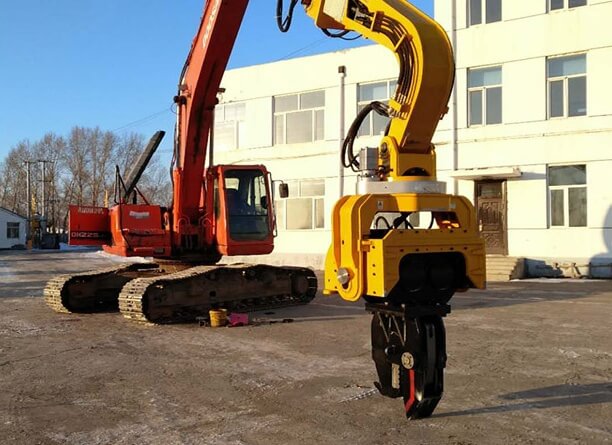Using an hydraulic flail mower for excavator can significantly enhance productivity in vegetation management, land clearing, and general landscaping. However, the powerful machinery and sharp cutting tools also pose considerable risks if not handled correctly. This guide covers essential safety measures, potential hazards, and best practices for using an excavator flail mower safely.
Introduction to Hydraulic Flail Mowers For Excavator
Hydraulic flail mower for excavator is a versatile attachment used for cutting and shredding vegetation, such as grass, bushes, and small trees. It is mounted on the arm of an excavator, providing extended reach and maneuverability, making it ideal for challenging terrains and large areas. Despite its benefits, operating an excavator flail mower requires careful attention to safety protocols to prevent accidents and injuries.
Pre-Operation Safety Checks
-
Equipment Inspection:
Visual Inspection: Before using the hydraulic flail mower for excavator, perform a thorough visual inspection. Check for any visible damage, loose parts, or signs of wear and tear. Ensure that the blades are sharp and securely attached.
Hydraulic Connections: Inspect the hydraulic hoses and connections for leaks or damage. Properly functioning hydraulics are crucial for the safe operation of the flail mower.
Attachment Securement: Confirm that the flail mower is securely attached to the excavator’s arm. Loose attachments can lead to dangerous detachment during operation.
-
Operator Safety Gear:
Personal Protective Equipment (PPE): Operators should wear appropriate PPE, including a hard hat, safety glasses, hearing protection, gloves, high-visibility clothing, and steel-toed boots. PPE protects against flying debris and other potential hazards.
First Aid Kit: Ensure a first aid kit is readily accessible in case of an emergency.
-
Site Assessment:
Hazard Identification: Assess the work area for potential hazards, such as power lines, uneven terrain, rocks, and other obstacles. Mark or remove hazards where possible.
Weather Conditions: Check weather conditions before starting work. Adverse weather, such as rain or strong winds, can increase the risk of accidents.
Operating the Excavator Flail Mower
-
Starting Procedures:
Operator Training: Ensure the operator is adequately trained and familiar with the controls and functions of both the excavator and the flail mower attachment.
Engine Start-Up: Start the excavator’s engine following the manufacturer’s instructions. Allow the engine to warm up before engaging the flail mower.
-
Operational Safety:
Control Familiarization: Operators should be familiar with the controls of the excavator and the flail mower attachment. Practice smooth and controlled movements to avoid sudden jerks or swings.
Clear Communication: Maintain clear communication with any ground personnel. Use hand signals or communication devices to ensure everyone is aware of the mower’s movements.
Proper Positioning: Position the excavator in a stable location. Use the excavator’s arm to position the flail mower at the correct height and angle for cutting.
Throttle Control: Use the appropriate throttle setting for the task at hand. Running the mower at excessively high speeds can lead to loss of control and increased wear on the equipment.
Cutting Techniques: Move the hydraulic flail mower for excavator steadily and avoid sudden movements. Overlapping passes ensure thorough vegetation cutting. Always cut on the downhill side if working on slopes to prevent the excavator from tipping.
Addressing Potential Dangers
-
Flying Debris:
Risk of Projectiles: The hydraulic flail mower for excavator can eject debris at high speeds, posing a risk to the operator and bystanders. Always operate the mower with the protective shields in place.
Safe Distance: Maintain a safe distance from other workers and structures. Establish a safety zone around the work area to prevent unauthorized access.
-
Machine Overload:
Avoid Overloading: Do not overload the flail mower by cutting vegetation that is too thick or dense. Overloading can strain the machine and lead to mechanical failure.
Monitor Engine Load: Keep an eye on the excavator’s engine load and temperature gauges. If the engine is overheating or the load is too high, reduce the workload and allow the machine to cool down.
-
Terrain Hazards:
Stability Concerns: Be mindful of the excavator’s stability, especially on uneven or sloped terrain. Avoid operating the flail mower on steep inclines to prevent tipping.
Obstacle Awareness: Watch for hidden obstacles, such as rocks or tree stumps, which can damage the flail mower or cause sudden jolts.
-
Mechanical Failures:
Regular Maintenance: Perform regular maintenance on both the excavator and the flail mower attachment. Follow the manufacturer’s guidelines for lubrication, blade sharpening, and part replacement.
Immediate Repairs: Address any mechanical issues immediately. Continuing to operate with a malfunctioning machine can lead to accidents and further damage.
Post-Operation Procedures
-
Shut Down:
Safe Shutdown: Gradually lower the flail mower to the ground and disengage the cutting mechanism. Allow the engine to idle for a few minutes before turning it off.
Hydraulic Release: Release hydraulic pressure from the system to avoid accidental movements during maintenance.
-
Inspection and Cleaning:
Post-Use Inspection: After shutting down, inspect the flail mower and the excavator for any signs of damage or wear. Check for loose bolts, hydraulic leaks, and blade condition.
Cleaning: Clean the flail mower to remove any debris or plant material. This helps prevent rust and ensures the mower is ready for future use.
-
Maintenance Record:
Log Maintenance Activities: Keep a detailed record of all maintenance activities, including inspections, repairs, and part replacements. This helps track the condition of the equipment and ensures timely maintenance.
Conclusion
Using hydraulic flail mower for excavator can greatly enhance efficiency in vegetation management and land clearing projects. However, the power and potential hazards of the equipment necessitate strict adherence to safety protocols. By conducting thorough pre-operation checks, following safe operating procedures, and addressing potential dangers, operators can minimize risks and ensure a safe and productive work environment.
Always prioritize safety over speed, and never hesitate to stop work if conditions become unsafe. Proper training, regular maintenance, and vigilant operation are key to safely using an excavator flail mower.
[/fusion_text][/fusion_builder_column][/fusion_builder_row][/fusion_builder_container]







Leave A Comment